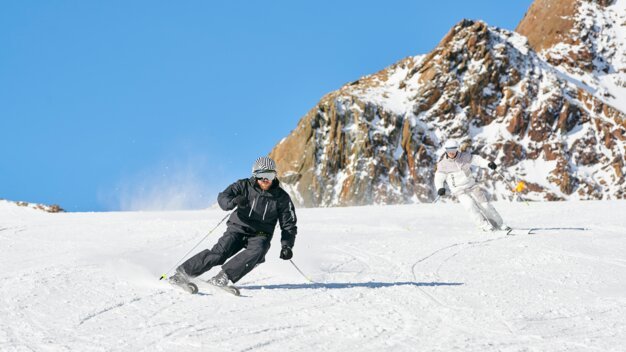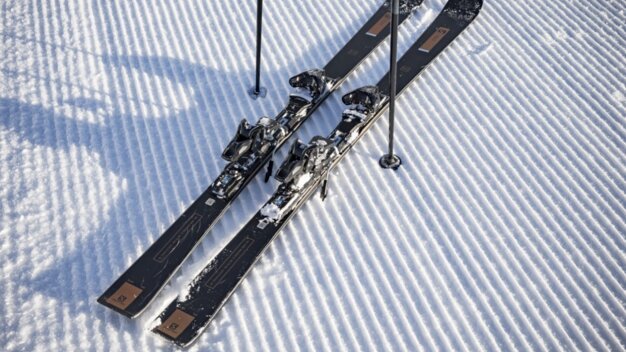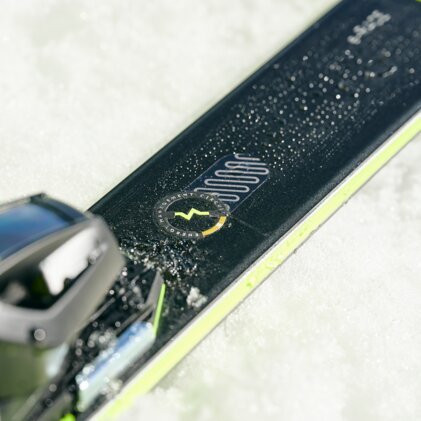
Skiing on freshly waxed skis with a fresh base is balm for the soul of every skier. The skis run smoothly over the snow, almost like new. And the fun on the slopes is taken to the next level. But regular ski waxing has another advantage: it maintains and protects the skis at the same time, prolonging their life.
INTERSPORT Rent provides you with instructions on how to wax your skis yourself. We also explain when and how often you should do it.
Checklist: The right equipment and tools to wax your skis
Before you set off, we'll give you a few tips on the right equipment. If you're missing any accessories, you can find them in your local INTERSPORT Rent shops. You have the choice: Either you buy a ski care set with all the right materials right away, or you can buy your equipment and tools to wax your skis with the following checklist.
- Device for securely fastening skis to the table
- Universal wax
- Wax iron (alternative: use an old iron from your household)
- Nylon or copper brush
- Plastic scraper blade
- Soft cloth
Tip: In addition to universal wax, different types of wax are used to treat skis. Hot wax with low fluorine is ideal for the bases of hobby skiers who are travelling on normal slopes.
Instruction manual: How to wax your own skis in 8 steps
- Mount skis on a table.
- Thoroughly clean and dry the base with a brush and cloth.
- Heat the wax with an iron, ...
- ... spread the wax evenly on the ski with an iron.
- Wait for the wax to cool and dry (at least 30 minutes).
- Remove excess wax with a plastic scraper blade.
- Then use the brush along the base.
- Remove dust with a soft cloth.
Caution: Be careful when using a conventional household iron! The temperature must remain constant at around 140 degrees Celsius (depending on the type of wax). Too much heat will damage the ski. Therefore it is best to use the wool/silk program!
Your advantages of a perfect ski base
Did you know that you don't actually ski on the snow directly? The pressure and friction create a small layer of water on which you glide. These properties also change depending on the surface structure of the base. So, its performance is heavily influenced by the outside temperature and humidity. The type of base changes the manoeuvrability and directional stability of the ski:
- Fine base structures: They increase the gliding aspects at cold temperatures if the snow crystals are fine.
- Coarse base structures: They improve the riding at warm temperatures if the snow crystals are coarse.
- Arrangement of the base structure: Depending on the requirements, linear, crossed or offset reliefs influence the gliding properties when skiing.
When the base is waxed, the fine pores of the ski base are additionally filled. This not only makes your skis glide better, but it also serves as a protective layer. After a long season, only the wax layer needs to be renewed, not the entire base.
How often do you really need to wax skis?
Waxing your skis fulfils several purposes: It prevents the base and edges from drying out and makes the pores supple. If the structure of the ski can no longer displace the water from the snow, you often get stuck on the slopes.
How often your skis need to be waxed depends, among other things, on how often you ride them. Waxing should take place at least at the end of each season. The wax serves as care, protects the ski and at the beginning of the next season you can fall back on a serviced ski. If you use your skis intensively, a service can also be useful during the winter to protect the material and give you the best performance.
It's time to check the base and the skis when ...
- … temperature and snow conditions change, for example from wet to dry snow.
- … there is fresh snow.
- … the colour of the ski base looks greyish to dull and feels rough.
- … you store your skis for the summer to protect them from rust.
- … you see deep scratches on the base of your skis.
- … you notice dirt on the surface that can no longer be removed.
Does it make sense to wax skis yourself?
It is always a good idea to look after your equipment and take care of it. Well-maintained gear makes a day on the slope twice as much fun. It is perfectly feasible for amateur skiers to wax their skis themselves, following the steps mentioned above.
If you want to start waxing skis yourself, you should have the necessary equipment and tools. We have already listed these earlier. For someone who skis a lot, has the space in the basement and can wax the family's skis at the same time, it is definitely worth considering investing in the necessary equipment.
Your skis have deep scratches, the edges are rusted or you've hit a rock while powder skiing and the core is visible? In such cases, we recommend a full service. Our INTERSPORT Rent shops are well equipped and our ski experts will help you out.
Do I also have to wax new skis?
Normally, newly purchased skis are waxed. In this case, the ski wax has already been applied at the factory. If you want to maximise performance, you can of course wax them again. Alpine ski racers, for example, tend to do that so they get the best gliding performance according to the current snow conditions.
In principle, however, there is no such thing as "too often" when it comes to ski care. The situation is different with used skis. These may not have been freshly waxed by the previous owner. In this case, we recommend one of our all-round ski or snowboard services.
Frequently asked questions about waxing skis:
What is ski wax?
The wax used on skis is a coating made from synthetic and natural materials. The basic components are usually petroleum-based, although the ratio of the composition changes depending on the intended use - whether for warm or cold snow.
What happens if I don't wax my skis?
The wax you apply on the base improves the gliding properties and also guarantees protection. As soon as the wax layer is removed, the ski glides more poorly over the snow. In addition, damage to the base can now occur directly on the ski surface and no longer just on the wax layer.
Are there alternatives to ski wax?
Time and again, the internet is buzzing with claims that you can also use bee wax or candle wax for the base. However, you should steer clear of this if your aim is to improve performance. The types of wax offered by manufacturers are optimised for use on skis, increase the gliding properties and protect the base.
How often is a ski service advisable?
This service is generally recommended at the end of each season, as the wax layer maintains the skis and preserves them until the next winter. A ski service at INTERSPORT Rent consists of the following points - regardless of whether it is a small or large service:
- Polishing the base
- Sharpen the edges
- Waxing the base of the ski
How often a ski service is necessary within a season depends on the intensity of use. If you ski a lot and therefore wear out the edges and the base equally quickly, you should also have your skis serviced during the season. However, as soon as the base is damaged by contact with stones, it is time for a ski service to prevent consequential damage.
INTERSPORT Rent Tip
Waxing your own skis is particularly suitable for frequent skiers who regularly repair their base and then wax it themselves.
Our recommendation: If you only visit the slopes a few times a year and don't yet have the right equipment, you are probably better off with a ski service on site. Your advantage: The experienced RENTertainers adjust the tuning to the current snow conditions. In the INTERSPORT Rent shops, the ski bases can be repaired, edges can be sharpened and of course we are going to apply some ski wax. All so you can get back on the slopes in no time.
Related articles
You may also be interested in:



